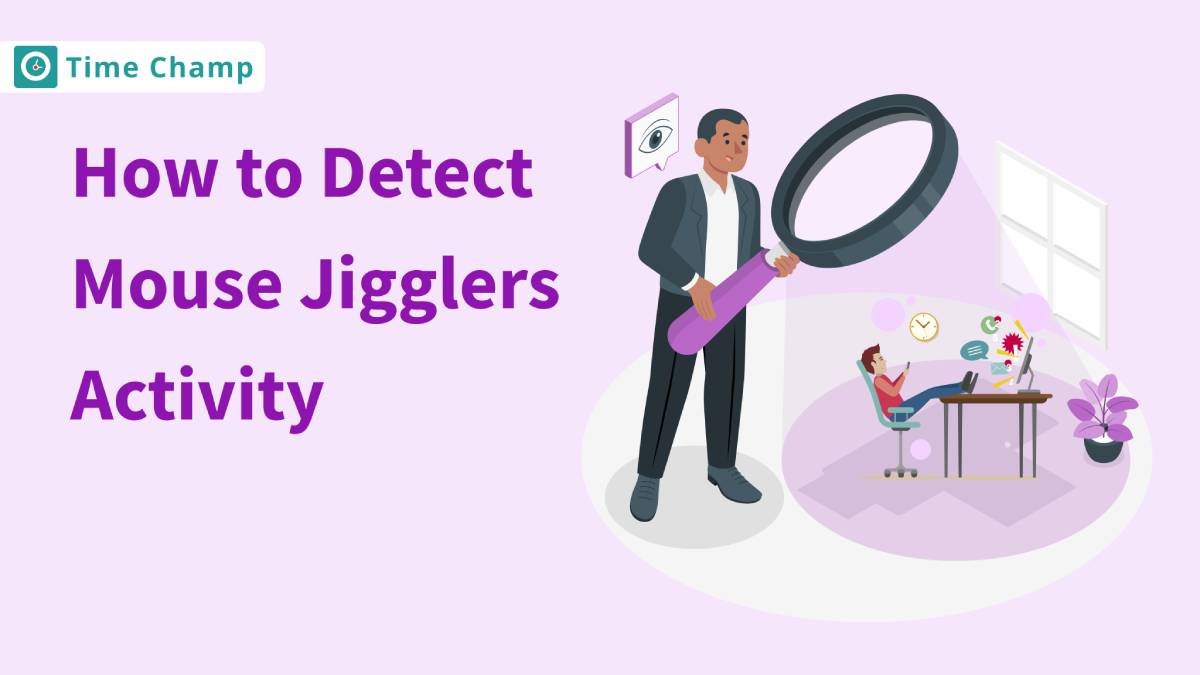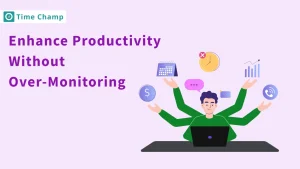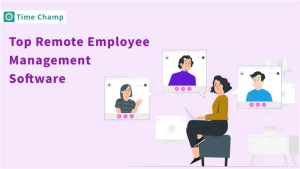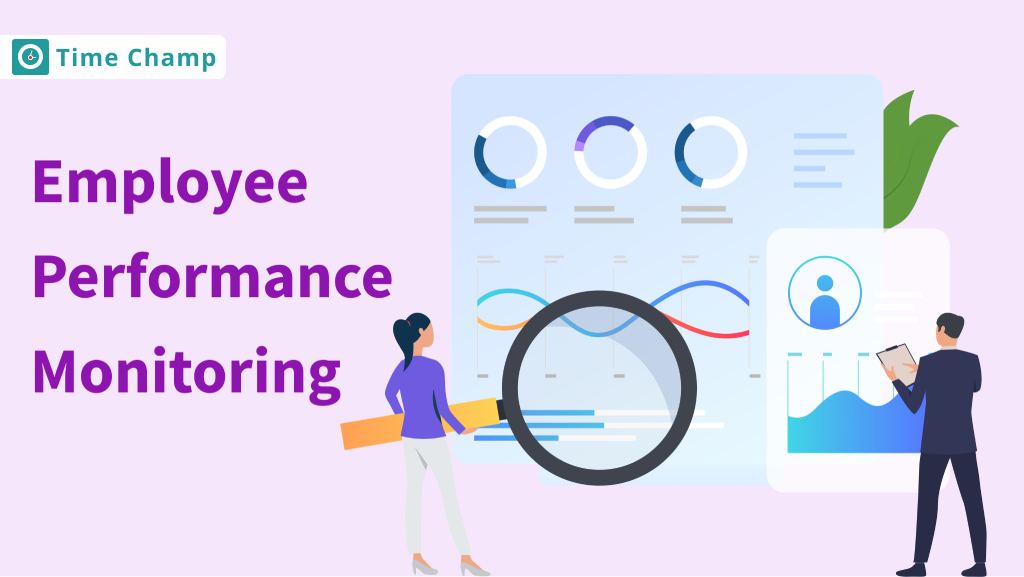Hey, we need to talk about this sneaky trend in the workplace, it’s mouse jigglers. These little software programs or devices keep the computer awake, making managers believe that their employees are hard at work when they are really not. It’s a little like having an online ghost! But, no need to worry, we will discuss how to detect mouse jigglers and keep your employees honest. Get yourself something to snack on while we dive into the details of mouse jigglers.
What is a Mouse Jiggler?
A mouse jiggler is a device or software that mimics mouse movements to keep a computer from detecting inactivity, all without the user having to physically move the mouse.
By subtly moving the cursor at regular intervals, it tricks the system into thinking that the user is active, which can stop screensavers from kicking in, notifications about inactivity, or automatic logouts. Many people use mouse jiggers when they’re busy with long tasks or when they need to keep their devices active, especially in work environments where inactivity is tracked. It’s a simple way to maintain activity without having to constantly interact with your computer.
Different Types of Mouse Jigglers
There are mainly two types of mouse jigglers: hardware and software, such as mouse mover apps and mouse mover browser extensions.
1. Hardware Mouse Jigglers
Physical mouse jigglers are small devices that you can handle physically and attach to your computer. They are connected to the USB port of the computer. When connected, they begin to move the mouse cursor on the screen automatically. This mouse movement is continuous, which makes it look as if somebody is actually operating the mouse. These devices can be considered miniature robots that constantly change the position of the mouse cursor in multiple ways.
However, one issue with the physical mouse jiggler devices is that they are quite visible in office work environments. Because they are material components connected to the computer, they are visible to anyone with the naked eye. This makes them more likely to be detected by employers, or the IT people once they notice the device.
But, when used in remote work environments it is difficult to detect these automatic mouse movement tools as the employers cannot directly see the mouse moving devices. Although these are virtually invisible, they also have a drawback employees must remember to place the mouse on these mouse wiggler devices.
To avoid this extra step of remembering to do so the worker likes to use USB-based mouse movers which run automatically when connected to computer systems and keep the computer screen active. Even though the USB mouse movers are easy to use they are also very easy to detect and prevent from using.
2. Software Mouse Jigglers
The software mouse jigglers are more undetectable than their physical counterparts. These are software applications that are installed directly into the computers. When installed, they run in the background and control the mouse cursor, mimicking the natural mouse movements. This kind of mouse mover app is much more difficult to detect because it has no physical proof.
But they are not completely undetectable. With the right technical expertise, these software programs can be detected by a scan of the installed software programs on the computer or the system files. Since they are digital, they leave a trail in the computer system that can be easily traced.
3. Browser Extensions
The simplest form of this technology is the browser extensions for mouse jigglers. They are added directly to the web browser, and their main purpose is to maintain the employee’s online status. They are highly user-friendly and are very easy to install. However, their functionality is confined only to the browser on which they are installed. This means they can only ensure that the employee is kept active in the browser and that it has no effect on other applications or the operating system of the computer.
These extensions are useful for individuals who would like to stay active in web-based applications or services, but these are less functional in comparison with other sorts of mouse jigglers.
Why Do Employees Use Mouse Jigglers?
Often, employees use mouse jigglers to cope with the rigid productivity tracking tools in today’s work environments. In many workplaces, being inactive on a computer, no matter whether the employee is reading, thinking, or on a video call, can trigger unnecessary alerts or pauses in productivity tracking software. This creates frustration when real work doesn’t always mean constant mouse movement or typing. Mouse jigglers provide a subtle solution, allowing employees to carry on with their tasks without worrying about being flagged as idle.
Some employees show interest in these mouse jigglers to trick their employers into thinking that they are actually working. This tactic can create a false impression of productivity, potentially undermining trust in the workplace.
For remote and hybrid workers especially, mouse movers offer a sense of control in managing the “always online” culture that some workplaces enforce. Employees use these tools to ensure their focus isn’t disrupted by having to constantly prove they’re working. Whether they are away from their desks for just a few minutes, in a meeting for an hour, or performing tasks where they cannot use their computers, mouse jigglers serve as a protective measure for employees against idle time tracking.
Now let’s take a look at some mouse jiggler detection methods.
How to Detect Employees Using Mouse Jigglers
Detecting Mouse Jigglers in the workplace involves a few strategic approaches:
Inspect Work Computers for New Installations
Just think of this as a mini-investigation in your own office. The essence here is to analyze the applications and devices that are connected to or installed on the computers of the employees. Look for any unknown software or any strange devices that are connected to the USB ports of the computer. These can be possible mouse movers. Think about new programs that don’t quite fit with standard workplace tools or odd gadgets that don’t seem to have a clear purpose. This process involves constant vigilance and sharp observation of the details that may appear to be unusual. It is possible to detect the automatic mouse movers by identifying such anomalies through regular checks.
Set Response Time Limits for Employees
Setting response time limits is a very simple yet very effective approach. This method is similar to setting a real-time test of responsiveness. You can set specific timeframes during which the employees must respond to the messages or requests to measure their presence at their workstations. If an employee does not respond within the expected time frame several times, it can indicate that they are not using the computer but using a Mouse Jiggler to simulate work. This approach is like playing the game of Marco Polo, where the absence of a timely response indicates that something is wrong.
Implement Employee Monitoring Software
You can also implement employee monitoring software like Time Champ to detect these mouse jigglers on your employee computers.
Time Champ helps detect mouse jiggler activities while ensuring that productivity data is authentic or reflects real work. With intelligence, it safeguards against possible misuse and ensures fairness regarding the tracking of employee performances.
Here’s how Time Champ makes it happen, with each feature explained in detail:
1. Smart Input Monitoring
Time Champ closely monitors the mouse movements and the dynamics of keystrokes in order to identify suspicious patterns. You can receive alerts when a particular keystroke is pressed too many times.
Even if a mouse jiggler tries to trick the system, Time Champ helps you differentiate between real employee engagement and artificial inputs using the employee user activity reports.
This means productivity metrics genuinely reflect work effort rather than simulated activity.
2. Screen Recording for Transparency
Time Champ takes periodic snapshots or records activity on the screen to ensure everything aligns together perfectly.
You can watch screen recordings to determine if any user is using a mouse jiggler instead of being productive. These records help verify data and make fair assessments.
With this feature, you get a clear picture of what’s really happening.
3. Alerts for Suspicious Behavior
Time Champ sends real-time alerts if something seems off. Continuous activity with no variation could indicate the use of a jiggler.
You can get alerts for any unusual work patterns, like a sudden drop in productivity. These alerts ensure quick detection and immediate action, keeping things fair and transparent.
4. Accurate Idle Time Tracking
Mouse jigglers are programs that pretend to do work to cover for inactivity, Time Champ can still see through it. It tracks actual engagement versus idle time, even if artificial tools are in use.
Employees can’t rely on any tricks to cover up inactivity, ensuring everyone is accountable. This feature helps maintain accuracy in performance reviews.
5. Connecting Activity to Results
Time Champ integrates activity data with task tracking, making it easy for you to see if work matches the time spent.
If tasks aren’t completed despite high activity, it’s a sign that something isn’t right. By linking effort to results, the system prioritizes meaningful work over empty metrics.
This makes sure that teams working on projects give their best towards the delivery of output instead of wasting their time.
6. Visual Heatmaps
Heatmaps functionality in Time Champ is a simple way to view activity trends.
If activity levels are unusually consistent or show no natural breaks, it could indicate artificial input. You can quickly identify irregularities at a glance, saving time and effort.
This feature makes the data more accessible and feasible.
7. Tailored Reports for Deeper Insights
Time Champ’s reporting tools allow you to customize what you track and analyze. These reports highlight periods with unusual activity for further review.
By combining input data, screen recordings, and task completion, you get a 360-degree view of productivity. These reports make decision-making easier and more informed.
Bring transparency and efficiency to your workplace with Time Champ’s smart monitoring
Sign Up for FreeBook DemoAre These Mouse Jigglers Even Legal?
Mouse jigglers, those little gadgets or software tools that keep your computer from going idle, often raise a lot of questions about legality. Technically, they aren’t illegal, but they can land you in hot water if they go against your workplace policies. For instance, if your company uses productivity tracking tools, using a mouse mover to fake activity might be seen as dishonest. It’s always better to check your company’s rules before you plug one in.
The bigger question is about intent. If you’re just trying to keep a slideshow running during a meeting, it’s usually harmless. But if you’re using it to trick your employer into thinking you’re working when you’re not, that’s where things can get messy. Being upfront and honest is always the safer route. If you’re unsure, it’s worth asking your IT team to avoid any trouble.
Disadvantages and Risks of Mouse Jigglers or Automatic Mouse Movers
1. Creating a False Image of Productivity
Although Mouse Jigglers may seem to be a very simple way of keeping a computer active, their use could cause some false perceptions in the workplace. When employees use the automatic Mouse movers, they give the illusion that they are very productive even when they may not be. It is similar to the situation when a movie is being played in the background; it gives an impression of activity, but in fact, no productive work is being carried out. This misrepresentation can be very problematic in evaluating the real work output and productivity.
2. Impact on Trust and Team Dynamics
Using automatic mouse movers has a tremendous effect on the trust among the employees in a team or organization. Trust is a very important component of a positive work culture, and when you are not sure if your employees are genuinely doing the work, it can destroy this trust. It is like trying to build a house on the most unstable foundations, it is very difficult and can result in many problems with team cohesion and morale.
Additionally, when productivity metrics get distorted due to the use of Mouse mover apps or devices, it becomes very challenging for the management to effectively evaluate and manage employee performance. It is like cooking without knowing what ingredients you have in your kitchen, you cannot predict the result.
3. Security Concerns
Another major security risk associated with using Mouse mover devices is that when a mouse jiggler keeps a computer active, it is as though the computer is unattended while all the systems are operational. It’s like opening your front door and walking away, leaving your computer vulnerable to unauthorized access. If the user is not around to monitor who might access the computer, sensitive information could be at risk as the computer remains active. This open access can cause security breaches where sensitive information could be viewed or altered.
Mouse Jigglers create a false portrayal of employee activity, destroy trust and teamwork in the workplace, and raise serious security risks by leaving computers vulnerable to unauthorized access. These factors make the use of mouse-moving apps a concerning practice in professional settings.
Conclusion
And yeah, you have it, your complete guide to understanding and detecting mouse jiggler activities. It’s a bit like a game of hide-and-seek, but with the right knowledge and tools, you can ensure that your workplace remains a place of honest work and integrity. Stay curious, stay alert, and implement measures that encourage honest work ethics. After all, a workplace built on trust and transparency isn’t just more productive, it’s also a place where everyone feels happier and healthier while working.
Achieve greater work efficiency and optimize time management with Time Champ
Sign Up for FreeBook DemoFrequently Asked Questions
Mouse movers, especially software-based ones, typically don’t harm computer systems directly, but they may slow down performance if they consume significant resources.
Some antivirus programs can detect software mouse movers as potentially unwanted applications (PUAs), especially if they alter system settings.
Employees use Mouse Jigglers or automatic mouse movers in the workplace to create an illusion of using the computer actively. It may be to prevent the computer from entering sleep mode, activate screen savers, or maintain an ‘online’ status on chat applications or work platforms. Primarily, it mimics activity to prevent the discomfort of inactivity or to create a false appearance of being busy.
Yes, mouse movers work independently of the type of mouse in use, as they either simulate activity through software or directly manipulate the cursor using hardware. Even advanced mice with unique functionalities are generally unaffected by jiggler activity.
Using a VPN does not inherently hide the use of mouse movers, as these tools operate at the device level. However, VPNs can mask internet activity, making it harder to trace browser-based mouse shaker extensions. Comprehensive monitoring tools can address this gap.
No, mouse shakers cannot bypass biometric authentication systems like fingerprint scanners or facial recognition. These tools only simulate cursor movement and do not interact with advanced security measures.






